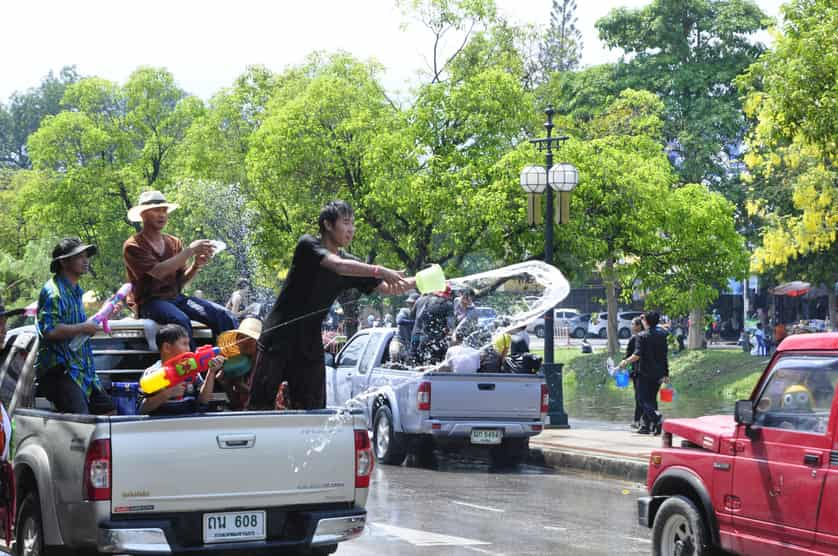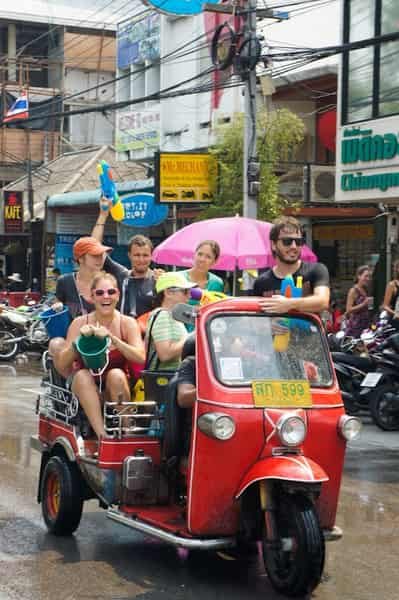April might be the hottest month of the year in Thailand, but it also is when one of most festive holidays of the year is celebrated: Songkran Festival or the Thai New Year. Every year, the number of tourists coming from different regions of Thailand and different countries around the world increases. Songkran may seem like a fun and wild festival filled with water battles, but many of the younger generations and also tourists forget that Buddhism has an important role as to why Thai people celebrate Songkran, with each region, city, town and even village having its own traditions, making for a vibrant and cultural experience.
Before Songkran became a wild water war festival, water was only used for ‘song nam’ or the pouring of lustral water on respected persons or the objects of worship. From such gentle aqua beginnings, water has gradually become a tool for playful fun in which people throw water on each other.

Paveni Pi Mai in Chiang Mai
The Lanna people celebrate Songkran quite differently from other regions. According to Tradition New Year Festivals in Five Countries: A Comparative Cultural Study by Songsak Prangwatthanakun, it is stated that Songkran, “New Year Festival” or commonly known as Paveni Pi Mai is celebrated in the Lanna 7th lunar month. Paveni means tradition while Pi Mai means New Year. Other festivals in Thailand are linked to the lunar calendar, however Songkran is fixed by astrological calculation: it occurs when the sun moves out of the sign of Pisces into the sign of Aries. This event falls on April 13, 14 and 15 but it has been conventionally fixed on the 13th of April.
Compared to other regions in Thailand, the Lanna Songkran covers many more days. In the past, the Paveni Pi Mai in Chiang Mai used to be celebrated over six consecutive days. The six days of Paveni Pi Mai consisted of a special activity on each day, specific to a location in the city. Starting at Wan Sangkan Laung on the first day, through Wan Nao, Wan Phaya Wan, Wan Pak Pi, Wan Pak Duan, and Wan Pak Wan over the remaining five.
The three days celebrated now take place in time with the rest of the country, from 13th April to 15th April due to the fast paced life of modern day jobs and responsibilities.
The Songkran Procession in Chiang Mai, 1990
Chiang Mai is also famed for its unique tradition whereby a grand procession is held, carrying Buddha images over a long route through the city. This tradition began in 1990 and is led by a group carrying the famous Buddha image of Chiang Mai known as “Phra Budda Sihing,” which is kept at Wat Phra Sing. Phra Buddha-Sihing is followed by 25 additional groups carrying other images and the parade is organised by government agencies and other private organisations.
Each year the procession takes place on 13th April, from the Chiang Mai Railway Station to Wat Phra Singh, covering a distance of four kilometres. It is believed that song nam or pouring water on the Phra Buddha-Sihing will bring you prosperity. The Phra Buddha-Sihing is then set on an altar outside Wat Phra Singh so people may visit and song nam over the three days.

As time passes, so does tradition. In this case, the act of song nam, pouring water on respected persons or objects, has transformed into a fun and nationwide water fight. People head into town armed with guns and buckets, splash water over each other, drink alcohol and almost forget about the traditions that gave birth to such a tradition.
Although Thais still pour water on their elders and even a Buddha statue or two, it almost takes a back seat with the younger generations. During the festival, people drink and inevitably drive too, which leads to the media and authorities dubbing the festival period as the ‘seven dangerous days’. It is a term used by Thai people to highlight the number of road accidents and deaths happening over the long holiday break. According to Thairath, the number of deaths from road accidents during April 11-17 in 2017 was a staggering 390 people. However, what is more (or less) surprising is that the average death rate over a one week period on the Thai roads is almost no different to that of the seven dangerous days.
According to Line Today, the average road accident death rate in Thailand is 54-56 deaths per day or 378 a week. This data corresponds to the World Health Organization (WHO) which states that Thailand’s death rate is around 20,000 deaths per year, putting us at number two in the world for most dangerous roads. After looking at this data, it’s possible to suggest that the ‘seven dangerous days’ are actually just a fear campaign to help reduce road accidents, which is not a bad thing although it may be a bit exaggerated.
Do’s and Don’ts during Songkran
- Save your favourite clothes for other occasions
It might not be one of the best ideas to wear your best shirt or best shorts for the festival, as you will be constantly soaked through by muddy moat water no doubt. Also think about colours running too, we’ve all been caught out by that error from time to time! As a rule, stay light on top and darker below! - Put on sunscreen
This year’s Songkran is expected to reach highs of almost 40 degrees Celsius, so don’t forget to cream up if you want to avoid a tan or a burn. You will be wet most of the day so you may forget how hot the sun is on your skin so if you keep slathered and you’ll be just fine. - Buy a weapon
No, we are not talking guns and axes here, it’s not the purge just yet. We’re talking water guns, buckets (for splashing not for Sangsom) or just about anything that can get you splashing your enemies with highest efficiency. - Wear sunglasses for protection
Sunglasses come in handy when you need eye protection from the scorching hot sunshine, but during Songkran they serve another purpose – to keep that dirty moat water out of your eyes! - Give up the motorbike
If you think heading out to town on a motorbike is a good idea, best think again. Sure you can navigate the dense traffic but it is very dangerous. The roads are slippery, and people love to splash bike riders, often causing them to swerve, crash or just look foolish. We recommend taking a walk around the moat instead, it’s much safe and much more fun! - Splash water with respect
Don’t get too carried away and splash everyone you meet. Avoid splashing water on monks, the elderly, and parents with babies. The rule also goes for those who clearly don’t want to be splashed. We get it, it’s a fun festival but people have their reasons! Our editor once arrived at the airport and on the way to his hotel got so soaked that it ruined his passport and his visa stamp disappeared! - Keep your tops on
Over the last few years, police have been cracking down on topless men (as well as women) so our advice is keep your shirts on. The rules last year were no sexual dancing, no abs or bare chests, so those with beer bellies should be fine.
Five Top Spots for Songkran in Chiang Mai
- City Moat and around the Old Town
The most famous and busiest place for Songkran in Chiang Mai is of course the moat. With all that water just waiting to be used, it makes sense. Alcohol is banned around the moat to keep people safe as there are a lot of children and teenagers to frequent the area. - Tha Pae Gate
Tha Pae Gate is technically on the moat, but it is the biggest landmark of the city almost. The famous Phra Buddha-Sihing procession will pass this area, so you can song nam as the Buddha image passes. Tha Pae Gate is also home to a number of locally organised events, concerts and activities over the three days and is most popular with foreign tourists. - Kad Suan Kaew Shopping Centre

This was the original ‘hot spot’ for Chiang Mai Songkran some moons ago, although it has been shadowed by bigger and more modern shopping malls in recent years. Saying that, the mall still holds one of the best concerts during Songkran in Chiang Mai fully equipped with water guns and refiling stations. It’s also away from the moat so alcohol is a little easier to come by, although still banned in the concert area itself. - Huay Tung Tao
If the city craziness has just got too much for one day, or three days for that matter, then take a break and head to Huay Tung Tao where you can swim, relax and eat some really good local food. - Mae Wang
Although far from the city centre, Mae Wang is the place to go for bamboo rafting and a riverside mountainous Songkran adventure. Head out there with some snacks, a few cans of beer and you best mates and spend the day drinking and frolicking down the river.

